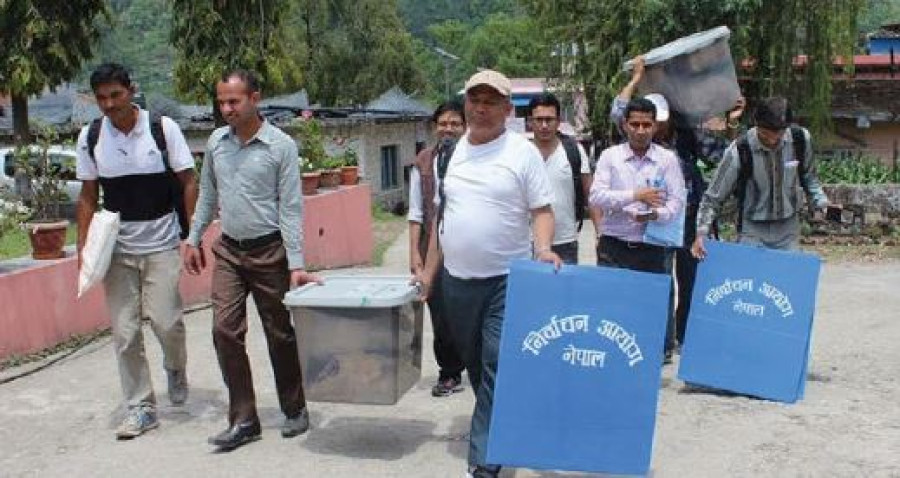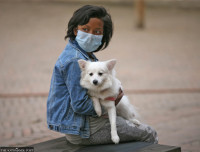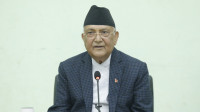National
More than 50 different items are needed for polls, Election Commission says as preparations begin
Even if Supreme Court decides Oli’s dissolution was constitutional, dispute in Nepal Communist Party has to be settled before polls are possible.
Prithvi Man Shrestha
If the Supreme Court reinstates the House of Representatives Prime Minister KP Sharma Oli dissolved on December 20, general elections slated for April 30 and May 10 will not take place.
But the Election Commission is legally bound to prepare for polls once the government announces the dates, according to Chief Election Commissioner Dinesh Thapaliya.
And preparations have started.
As part of it, it has been examining the situation of the logistics, budget, human resources for holding the polls.
Ballot boxes, ballot papers, vehicles, ink, voters’ list, stamp pad, pen, scale, ballot box stickers, medicines, papers, thread, calculators, glue sticks among the items it has to have for holding elections.
In the last parliamentary elections over 50 types of the election materials were used, according to the commission.
The election body expects to manage most of the necessary election materials by mid-March.
“We have to start transporting the election materials to various districts after mid-March,” said Raj Kumar Shrestha, spokesperson at the commission.
The most important of the materials is the ballot box and the Election Commission has said that it has around 90,000 ballot boxes from the last general elections in 2017 and this number should be enough provided they are fit and in proper condition.
“We are currently examining whether they are fit and in proper condition,” said Komal Prasad Dhamala, assistant spokesperson at the commission.
The stock of different election materials after completion of polls in 2017 have been kept at the stores at the commission’s head office and its district offices across the country.
The commission expects that only around 45,000 ballot boxes will be required considering that there will be about 20,000 polling booths across the country, if the last general elections is anything to go by.
“The required ballot boxes were estimated based on one ballot box for the first-past-the-post electoral system and one for the proportional electoral system,” said Dhamala.
Of the 275 seats in the House of Representatives, 165 will be elected through the first-past-the-post system while 110 will be chosen through the proportional representation system.
In the last federal and provincial elections, there were a total of 19,809 polling booths. Both federal and provincial elections were held on the same day in November and December 2017 and voters had to drop ballots in four boxes, two for federal parliament and two for provincial assemblies.
The commission expects to get some of the election materials from the donors too, according to Dhamala. In the last local elections held in 2017, India had donated several vehicles and China had provided many other materials for the elections like calculators, punching machines, rubber mat, stamp pads, glue stick among other things.
The most important of the materials required after the ballot boxes is probably the ballot paper and the commission has already begun discussions with the government-owned Janak Education Material Centre for printing ballot papers and other the election materials needed like posters for voter education.
“On Wednesday, there had been discussion regarding the printing of the election materials including the ballot papers. We are ready to print the voters’ list, ballot papers and other election materials,” said Chitra Achayra, spokesperson at the centre.
During the discussions, the commission had notified the centre that around 35 million ballot papers might be printed. According to the commission, there will be an estimated 16.5 million voters for the planned elections.
Double the ballot papers of total potential voters will be required based on the assumption that separate ballot papers need to be printed for the first-past-the-post candidates and proportional representation candidates.
“We can complete printing these ballot papers in 20-25 days,” said Acharya.
Besides logistics, the commission is also calculating the cost for holding the elections.
“We have not reached any conclusion regarding the budget. But, Rs7-8 billion might be required based on expenditure in the past elections,” said Dhamala.
In the last federal and provincial elections held in 2017, the commission had spent over Rs7.7 billion. Another Rs10 billion was spent for security arrangements, according to the Finance Ministry.
Besides preparation for logistics and budget estimates, the commission is also preparing to update the list of the voters.
“We are updating the voters’ list by keeping December 20 last year as the cut off date,” said Dhamala. “Updated list will be published on January 28 and people will get time for a week to make claims regarding the list—if somebody has been missing in the list and even dead persons have been included.”
Elections were announced on December 20.
Despite these preparations, the commission officials said that they are more concerned about the political situation as the ballot papers cannot be printed without solving the dispute in the Nepal Communist party.
The faction of Nepal Communist Party led by Prime Minister Oli has been asking the commission to continue election preparations while another faction led by Puspa Kamal Dahal and Madhav Kumar Nepal to stop election preparations terming the house dissolution and announcement of elections unconstitutional.
Also, as both factions are practically split, both are claiming that they are the legitimate party and the commission has not been able to decide that as neither side is following the party’s statute to claim legitimacy.
Chief Election Commissioner Thapaliya said that holding elections amid dispute in the Nepal Communist Party would be challenging.
“We hope that the situation will be clear regarding the dispute in due course of time. We are not the only entity that is looking into the dispute regarding the elections,” Thapaliya told the Post.
The constitutional bench of the Supreme Court is hearing the case of the constitutionality of the dissolution of the lower house.
If the court scraps the House dissolution and reinstates it, the preparations and resources spent could be wasted.
But Shrestha said that expenditure would not be huge in the initial phase of preparations for elections and total expenditure for poll preparations would depend on how long the Supreme Court takes to give verdict on house dissolution issue.
“Election materials purchased now could be used in the future elections even if elections don’t happen in April and May,” he said.




 5.39°C Kathmandu
5.39°C Kathmandu










%20(1).jpg&w=300&height=200)



